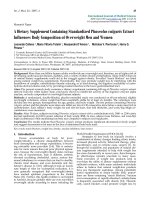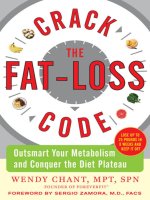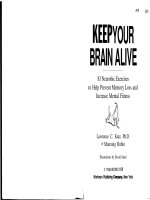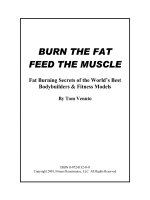41 offseason fat loss phase
Bạn đang xem bản rút gọn của tài liệu. Xem và tải ngay bản đầy đủ của tài liệu tại đây (502.05 KB, 19 trang )
UNIVERSITY
Offseason
Fat Loss Phase Planning
and Decision Making
Lesson Overview
•
•
•
•
•
•
•
•
•
What is the Fat Loss Phase
Initial Nutrition Set Up
Initial Cardio and Training Set Up
Initial PED Set Up
Decision Making
How Much to Adjust Calories
When to Adjust Protein, Carbohydrates, and Fats
Sample Fat Loss Phase Monitoring and Adjustments
When and How to End the Fat Loss Phase
The Fat Loss Phase
Fat Loss Phase “mini cut”: Brief fat loss phase during extended off
season
Not full-on contest prep
Goal: drop body fat and hold muscle tissue
• Nutrition is progressively decreased
• Training Stimulus must be held high to maintain tissue
• Cardio/NEAT may increase from offseason baseline or step count
increased
• If Enhanced, PED usage is elevated to hold tissue
• Fat Loss Phase can last 4-8 weeks
The Fat Loss Phase
Why implement a minicut in the offseason?
Muscle gain will come with fat gain (this is individual for timing)
Restore health variables
Decreasing body fat improves insulin sensitivity and lowers
inflammation
Lower aromatization from high body fat
GI given “rest” less food and improved appetite
Psychological break from Push Phase
The Fat Loss Phase
When to implement?
End of a holding phase or beginning of push up phase
NOT to be used within 3 months of post show for fat gain triage
Not to be used during times of high life stress and lack of recovery
variables (sleep, nutrition, PED)
Mid push phase is less than ideal for muscle retention
Might need a fat loss phase prior to a Comp Prep diet
The Fat Loss Phase
Physique expectations and assessment
• Holding new muscle or recomp if using PEDS
• Decreased body fat down to lower end of recommended ranges to
extend offseason (Males 8-12%; Females 18-22%)
• Initial weight loss can be from GI weight (food volume decrease, Muscle
glycogen decrease) Rate first week can be >1.5% body weight
• If PEDs increasing may see no change or increase in weight from water
retention.
• Plan will be adjusted based on subjective and objective data
• Idea is get in and get out of fat loss without any detriments in training
performance
• This is not a contest prep phase, we want to cut this phase off prior to
reaching a point of high metabolic adaption and need for hard fat loss
digging (No sleep disturbance, libido change, performance drops,
menstrual changes, digestion changes, etc)
Fat loss rate Goals:
From a high body fat a high rate of fat loss is possible and preserving
muscle tissue is much easier than in a lean state.
This should be “easy” fat loss before hard stalls happen
We don’t want to take too much time away from offseason
Rate: 0.5-1.5% weight loss per week
Variable Tracking
Tools to Track:
Weekly Pictures
Waist Circumference
3 largest caliper sites
Body weight
Fasting Blood Glucose
Weekly Blood Pressure
Daily Step Count
Gym Performance
Biofeedback
Lets look at each variable set up….
(Nutrition, cardio, training, PEDs)
Nutrition Fat Loss Phase Set Up
Coming off a holding phase
• Food intake has been close to maintenance level or slight surplus
• Should have adequate protein, carbs and fat to initiate
• Training volume will be brought up to hold lean tissue, this will drive a
slight increase in expenditure
• Food will need to be reduced 20-30% in calories
• This reduction initially should be a removal of offseason “non tracked
meals” “cheat meals” “junk food”
• Calorie reduction should come from carbs and/or fats from non periworkout meals
• Some of this can come from cardio increase
• PED introduction can enhance the fat loss effect on a smaller deficit
• Pull calories from meals that are not around training as a starting point
• Carbs and fats can be reduced individual or together depending on
starting point and preference.
Weekly weight
Weekly
Nutrition
Recommendations
Cutting
Energy
Protein
Fat
20-30%
below
maintenance
1.0-1.5
g/lb/day
0.30.7g/lb
/day
Carbohydrate
change
novice/interme
diate
1.0-3.0+
g/lb/day
0.5-1.5% per
week
weight
change
advanced
0.5-1.5% per
week
Training and Cardio/NEAT
Fat Loss Phase Set Up
Resistance Training:
• Train within your recovery capacity. PED introduction can allow for
higher training volume, volume should be higher than a holding
phase to hold tissue in a deficit, but less than peak push phase.
• Only straight sets, remove (drop sets, rest pause sets, beyond failure
sets) manage fatigue
• Add back in the training day removed during the holding phase: EX:
Pull Push Off Legs Off then to Pull Push Legs Off
• Continue normal load rep progressions like any other phase
Cardio/NEAT:
Increase in cardio if needing to keep food high. Ideally manipulate one
variable first (decrease food or increase cardio, then monitor response
Step count can be a focus of this phase, we are simply trying to
increase energy output.
I would try not to let direct cardio workouts exceed the number of
resistance training sessions you have per week.
PEDs Fat Loss Phase Set Up
AAS:
Move from TRT into a Blast
Can set up based on minimal needed for tissue holding
Can set up more aggressive to grow as well, base on previous cycle and rate of progress
GH:
Can hold GH 2-3 IU or move upwards to 4-8IU.
Time one dosage of 2IU pre fasted cardio
Insulin:
Not used during this phase
SERMS/Aromatase Inhibitors
Removed during this phase
Health Support Compounds:
Metformin
ARB/Telmisartan
Fat Loss Agents
Clenbuterol and T3 should be reserved for contest prep
Short duration low dose clenbuterol might be a consideration
Fat Loss Decision Tree
Fa t Loss Stall
No change to plan,
address adherence
NO
Adherence high >7-14 days
YES
Vi s ually l ook l eaner and decrease i n scale and/or caliper s ites?
YES
Fa t l oss within range of
0.5-1.5% wei ght l oss per
week?
NO
YES
YES
No change to
plan
Is Ca lorie i ntake high enough
a nd expenditure l ow enough
to a l low for for further deficit?
NO
Consider
ending
minicut and
start holding
phase
NO
Is tra ining performance i mproving or a t
l east maintaining?
YES
1st Consider
decrease kcal
when food is high
enough to do so
and hunger is
managed
NO
Consider adjusting
training volume
down or ending
minicut
NO
Other fa ctors involved
bl urri ng fat loss?
Di gestion Intact
PED cha nges
Mens trual cycl e
Food Volume
i ncrease/decrease
Poor Sl eep
Stres s
Wa ter retention from
tra i ning
Cha nge i n fluids
Cha nge i n daily routine
Cha nge i n check in time
of da y
YES
No change to
plan
2nd Consider increasing
energy expenditure if
calorie intake is low and
further decrease goes
below minimum targets
and curret cardio is not
highly fatiguing
3rd consideration we
will limit
implementation of
PED and fat loss
agents in a minicut
as a tool and save
that for contest prep
Adjusting Energy Intake
General Rules:
Make one change at a time
Changes made should be reactive not proactive after initial set up
Maintaining performance is paramount as this is not a contest prep
and we will not allow performance drops
Calorie adjustment after initial set up:
Option 1 : 10% decrease in total kcal intake (2000kcal diet = 200kcal
reduction)
Assess next week and adjust accordingly
Which macros to adjust?
Adjusting Macronutrients
Protein
Stay within 1-1.5g/lb of body weight, in a deficit protein needs will be
higher than in a holding or push phase
Hunger is also higher so protein with have the highest satiety index
Hunger strategies:
Swap liquid shakes for solid protein sources
Switch from fish and egg whites to turkey and chicken, more solid
protein sources
Adjusting Carbohydrates and Fats
CARBOHYDRATES
In fat loss phase an increase in training volume and cardio means an increase in glucose
utilization, but also fatty acid oxidation.
Coming from a push or holding phase carbohydrates should be relatively high and can be the
first macronutrient to adjust downward.
Uphold pre, intra and post workout carbohydrates for as long as possible to fuel
performance and recovery.
Switch to carb sources that have more fiber like oats over cream of rice to help manage
hunger.
Utilize veggies more in this phase to manage hunger also
FATS
However, look at fats as well. High carb or high fat can be just as effective in fat loss as one
another. So, preference and gym performance should be weighed into the decision of carb
or fat reduction.
Lowering fats may further increase hunger, which should be noted. I would not lower fats in
this mini cut lower than 0.3g/lb of body weight. Save the trace fat diet for later stages of a
contest prep.
Hunger can also be managed by switch to fat sources with more fiber like avocado and nuts
over using oils.
Adjusting Carbohydrates and Fats
General guidelines for picking a macro for adjustment:
Decrease carbs if: Carbs > 1g/lb and Fat is <0.3g/lb
Decrease fats if: Carbs<1g/lb and Fat is >0.7g/lb
Decrease protein if: Pro >1.3g/lb, Carbs<1g/lb, fat <0.3g/lb
Adjusting Energy Expenditure
Remember goal of cardio is only to create more energy expenditure
with least impact to training and recovery
Pick modalities with minimal impact on training increasing daily
activity and step counts. Treadmill>Elliptical>Bike>Stairmaster
Perform cardio during times that are far from training and don’t
impeded sleep duration
If cardio must be performed around training, do it after not pre.
You can adjust duration, intensity and frequency to program cardio.
Sessions longer than 20-30 min can be split to manage fatigue. Keep
intensity low to moderate intensity as HIIT can cause too much
interference effect.
Option 2: 10% increase in total daily expenditure (2000kcal diet=
200kcal cardio or step increase; ~10-15 minute cardio addition; 2k-4k
steps per day)
Hypothetical Male Bodybuilder Fat
Loss Phase Progression
week 1
weight
caliper
arm
quad
waist
BP
BG
rate of gain
Calories
Macros
Cardio
NEAT
Training
PEDS
pics
10,12,12
week 3
222
9,11,12
18.3
28.4
34.4
112/80
325/335/70
3x20
week 4
222.2
9,10,11
18.2
28.2
34.2
115/77
85
0.17
3270
8,10,10
18.3
28.4
34
112/70
83
1.4
2600
255/335/60
4x20
week 5
221
18.3
28.4
33.8
114/75
82
0.09
2600
255/335/60
4x20
219
8,9,10
18.2
28.3
33.5
112/67
80
0.5
2600
255/335/60
4x20
82
1
2600
255/335/60
5x30
5500
5500
5500
7500
7500
PPoffALoff
PPALoff
PPALoff
PPALoff
PPALoff
test 200; GH 2IU, Metformin Test 300, Masteron Test 300, Masteron Test 300, Masteron Test 300, Masteron 300, NPP 200,
500, telmisartan 20
300, NPP 200, GH 300, NPP 200, GH 300, NPP 200, GH GH 4IU, Metformin 500,
4IU, Metformin 500, 4IU, Metformin 500, 4IU, Metformin 500, Telmisartan 20
Telmisartan 20
Telmisartan 20
Telmisartan 20
softer
waist smaller,
tighter and fuller, tighter
tighter, at good body fat to keep
tighter
start of PED
gaining in push phase
Diet/hunger hunger decrease
Strength
maintain
PRS
Changes
week 2
225.4
hunger increase
maintain
8
Start Fat Loss Phase; 20% kcal
decrease, add 1 cardio
Hold diet same
session, Start PED blast
hunger increased
increasing
9
hunger same
increasing
10
same
increasing
10
9
diet same, increase
cardio by 10min and move to holding phase for one
increase steps 2000 add one session
week, increase food 20% kcal.
Ending the Fat Loss Phase
Time to end the Fat Loss Phase?
Is body composition at a leanness to move back to a push phase?
Was this a fat loss diet prior to contest prep?
Mentally feel fresh?
Next week can be a move to a holding phase then into a push or comp prep diet
Training:
Move to a deload week during the holding phase
Then training will move back up in volume based on the next phase you enter
Nutrition
Increase food to maintenance moving into holding phase
Cardio
Reduce cardio to offseason maintenance level
If cardio level was high taper down over a few weeks
PEDS
If fat loss phase was start of a blast then continue PEDs and incrementally increase as
needed to continue to grow
If fat loss phase was at the tail end of cruise dosage, you will move into a blast period
and increase PEDs
Summary
Fat loss phase is to drop body fat levels back to a level for improved
growth or prepping the body for a contest prep
The decision process in a fat loss phase should be based on around
scale weight rate of change, visuals and subjective feedback.
During a fat loss phase muscle retention and maintained gym
performance is essential. This is not comp prep, so we don’t want to
sacrifice muscle tissue in this phase.









